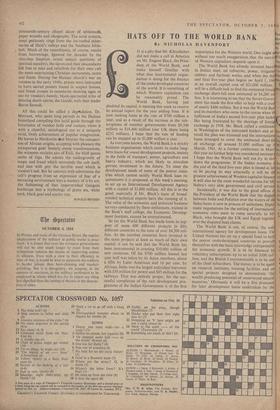Ogu and Shang°
Voodoo in Haiti. By Alfred Metraux. (Andre Deutsch, 30s.)
FotwEi • first, the Congo and Vachel Lindsay. At its height in the eighteenth century, when up to a hundred thousand Africans a year were shipped to the New World plantations, the slave trade cast its nets from Gambia to Angola. But its staple markets for 200 years were the shallow beaches of the Bight of Benin, the tragic coast of Togoland. Dahomey and western Nigeria. They were fed by the populous kingdoms of the Yoruba and Fon : peoples of ancient, elaborate and bloody religion, centred on the cult of ancestors and a pantheon of strong nature-gods. Some of their deities raise familiar echoes—Ogu the blacksmith, lord of fire and war; Shango the thunderer, with his dbuble axe; Ezili the fair, wanton and bejewelled; Damballah, the serpent •coiled around the world. and Legba the messenger, master of ways and oracles. To serve them, a large priestly caste pur- sued in monastic sanctuaries a highly formalised rite and discipline: ceremonies of Byzantine theatricality, chants of astonishing intricate classicism, dances whose every gesture was lan- guage. These were the sole possessions the slaves took with them to the West Indies.
What happened to all this in the New World is roughly what happened to ('hristianity. Voodoo,. the Haitian survival of Dahomey fetishism, is of about an age with Methodism and bears the same relation to dark old Africa as Billy Graham to the Vatican. The scarcity of clergy in the colonies, the isolation of backwoods settlements, bred the same decay of formal dogma, the same proliferation of prophets and sects, the same reliance on enthus- iasm and personal possession by the spirit. Voodoo is a 'revivalist' religion, with all the
nineteenth-century chapel decor of whitewash, paper wreaths and oleographs. The same ecstatic, nasal psalmody rings from the tin-roofed taber- nacles of Haiti's valleys and the Southern bible- belt. Much of the resemblance, of course, results from borrowings. Ignored for decades by the churches (baptism raised uneasy questions of spiritual equality), the slaves and their descendants felt free to take and refurbish for their own cult the more entertaining Christian sacraments, saints and feasts. During the Haitian church's war on voodoo in the early 1940s, priests were instructed to burn sacred posters found in suspect houses, and break crosses in cemeteries showing signs of use by voodoo's bawdy, black-spectacled tribe of dancing death-spirits, the Guede, with their leader Baron Samedi.
All this could be called a degradation. Dr. Metraux, who spent long periods in the Haitian hinterland compiling this lucid guide through the luxuriance of voodoo faith and custom, views it with a cheerful, sociological eye as a uniquely vivid, lively achievement of popular imagination. He leaves to Herskovits *td Mercier the compari- son of African origins, accepting with pleasure the transported gods' homely creole transformations, the winsome mulatto airs of Ezili, the bluff patois oaths of Ogu. He admits the undergrowth of magic and fraud which surrounds the cult itself, and sees with pity the terrible need which is voodoo's soil. But he conveys with admiration the cult's progress from an expression of fear of a menacing environment into a mastery of it by art; the fashioning of that impoverished Gauguin landscape into a mythology of green sea, white cock, black goat and scarlet tree.
RONALD BRYDEN







































 Previous page
Previous page